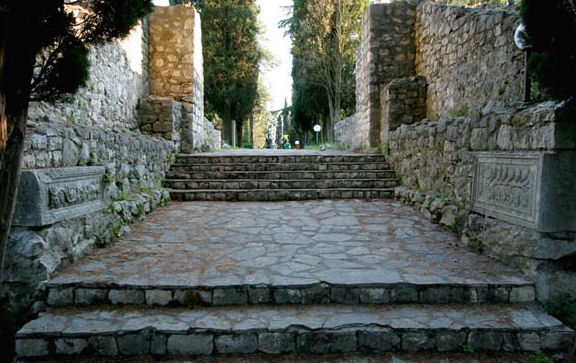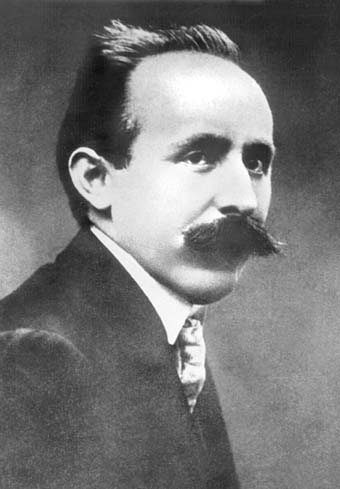|
Čobanija Bridge
ƒåobanija Bridge (; sh-Cyrl, –ß–æ–±–∞–Ω–∏—ò–∞ –º–æ—Å—Ç) is an iron pedestrian bridge located in Sarajevo, Bosnia and Herzegovina, spanning the Miljacka River. Constructed in 1887 during the Austro-Hungarian period, it replaced an earlier wooden bridge dating back to the 16th century. The bridge connects Kuloviƒáa Street on the right bank with ƒåobanija Street on the left bank and is situated near notable landmarks such as the National Theatre and the Main Post Office. History The original wooden bridge at this location was built in 1557 by ƒåoban Hasan Vojvoda, after whom the bridge, the adjacent street, and the nearby mosque are named. Following damage from flooding, the bridge was rebuilt by Sheikh Hasan Kaimija and became known as both ≈Ýejhanija and ƒåobanija Bridge. In 1887, during the Austro-Hungarian administration, the wooden structure was replaced with an iron bridge as part of broader modernization efforts in Sarajevo. This new construction reflected the archi ... [...More Info...] [...Related Items...] OR: [Wikipedia] [Google] [Baidu] |
Miljacka
The Miljacka ( sr-Cyrl, –ú–∏—ô–∞—Ü–∫–∞) is a river in Bosnia and Herzegovina that passes through Sarajevo. Numerous city bridges have been built to cross it. Characteristics The Miljacka river originates from the confluence of the Paljanska Miljacka and Mokranjska Miljacka rivers. The Miljacka is a rather small river, only long from the confluence, or and depending on source ( Pale or Mokro). By the time this tributary flows into the Bosna river in Sarajevo, it has an average discharge of 5.7 m3/s. The Miljacka river flows from east to west in a general direction through the city. The Bosna is a right tributary of the Sava River, with its mouth in Bosanski ≈Ýamac. That river in turn flows into the Danube River, which goes southeast and enters the Black Sea chiefly in Romania. Paljanska Miljacka The Paljanska Miljacka, in length, begins at Gornje Pale, eastward in the town of Pale, on the slopes of Jahorina, near Begovina), at an elevation of . Mokranjska Miljac ... [...More Info...] [...Related Items...] OR: [Wikipedia] [Google] [Baidu] |
Sarajevo
Sarajevo ( ), ; ''see Names of European cities in different languages (Q–T)#S, names in other languages'' is the Capital city, capital and List of cities in Bosnia and Herzegovina, largest city of Bosnia and Herzegovina, with a population of 275,524 in its administrative limits. The Sarajevo metropolitan area with its surrounding municipalities has a population of 592,714 people. Located within the greater Sarajevo valley of Bosnia (region), Bosnia, it is surrounded by the Dinaric Alps and situated along the Miljacka River in the heart of the Balkans, a region of Southeastern Europe. Sarajevo is the political, financial, social, and cultural centre of Bosnia and Herzegovina and a prominent centre of culture in the Balkans. It exerts region-wide influence in entertainment, media, fashion, and the arts. Due to its long history of religious and cultural diversity, Sarajevo is sometimes called the "Jerusalem of Europe" or "Jerusalem of the Balkans". It is one of a few major Europea ... [...More Info...] [...Related Items...] OR: [Wikipedia] [Google] [Baidu] |
Bosnia And Herzegovina
Bosnia and Herzegovina, sometimes known as Bosnia-Herzegovina and informally as Bosnia, is a country in Southeast Europe. Situated on the Balkans, Balkan Peninsula, it borders Serbia to the east, Montenegro to the southeast, and Croatia to the north and southwest, with a coast on the Adriatic Sea in the south. Bosnia (region), Bosnia has a moderate continental climate with hot summers and cold, snowy winters. Its geography is largely mountainous, particularly in the central and eastern regions, which are dominated by the Dinaric Alps. Herzegovina, the smaller, southern region, has a Mediterranean climate and is mostly mountainous. Sarajevo is the capital and the largest city. The area has been inhabited since at least the Upper Paleolithic, with permanent human settlement traced to the Neolithic cultures of Butmir culture, Butmir, Kakanj culture, Kakanj, and Vučedol culture, Vučedol. After the arrival of the first Proto-Indo-Europeans, Indo-Europeans, the area was populated ... [...More Info...] [...Related Items...] OR: [Wikipedia] [Google] [Baidu] |
Kulovića Street
Kulovića Street (; sh-Cyrl, Куловића улица) is a notable thoroughfare in the city center of Sarajevo, the capital of Bosnia and Herzegovina. It runs in a north–south direction, connecting Obala Kulina bana with Marshal Tito Street, and intersects with Branilaca Sarajeva Street. The street lies in close proximity to landmarks such as the Sarajevo National Theatre and the Sarajevo Youth Theatre. History Kulovića Street dates back to the Ottoman period, but received its current name in 1885 in honor of Sulejman Ruždija Kulović, a prominent Sarajevo judge and philanthropist. He financed the construction of a public fountain near Kalin Hadži Alija’s Mosque, which was later demolished in 1947. Siege of Sarajevo During the Siege of Sarajevo (1992–1996), the street was part of the so-called Sniper Alley, where civilians were frequently targeted by snipers positioned in the surrounding hills and buildings. To protect pedestrians, concrete slabs and makes ... [...More Info...] [...Related Items...] OR: [Wikipedia] [Google] [Baidu] |
Sarajevo National Theatre
The Sarajevo National Theatre ( Bosnian and Serbian: ''Narodno pozori≈°te Sarajevo'', –ù–∞—Ä–æ–¥–Ω–æ –ø–æ–∑–æ—Ä–∏—à—Ç–µ –°–∞—Ä–∞—ò–µ–≤–æ, Croatian: ''Narodno kazali≈°te Sarajevo'') is the largest theatre in Bosnia and Herzegovina and one of the most important cultural institutions in Southeastern Europe. History The founding of the Sarajevo National Theatre is marked by two significant dates. The first was 27 November 1920, when in the city of Tuzla, the theatre presented Hasanaginica by Aleksa ≈Ýantiƒá and Jedva steƒçe zeta by Labiche and Michel at the Bristol Hotel. The official inauguration, however, took place on October 22, 1921, marking the opening of its first season in the adapted building of the Social Hall in Sarajevo. The opening ceremonies spanned three days, drawing large audiences and numerous distinguished guests. Branislav Nu≈°iƒá, then Head of the Department of Arts at the Ministry of Education in Belgrade, delivered a welcoming address, which was met with ‚Äúe ... [...More Info...] [...Related Items...] OR: [Wikipedia] [Google] [Baidu] |
Austro-Hungarian Rule In Bosnia And Herzegovina
Bosnia and Herzegovina fell under Austria-Hungary, Austro-Hungarian rule in 1878, when the Congress of Berlin approved the occupation of the Bosnia Vilayet, which officially remained part of the Ottoman Empire. Three decades later, in 1908, Austria-Hungary provoked the Bosnian Crisis by formally annexing the occupied zone, establishing the Condominium of Bosnia and Herzegovina under the joint control of Cisleithania, Austria and Transleithania, Hungary. History Occupation Following the Russo-Turkish War (1877–1878), in June and July 1878 the Congress of Berlin was organized by the Great Powers. The resulting Treaty of Berlin (1878), Treaty of Berlin caused Bosnia and Herzegovina to nominally remain under sovereignty of the Ottoman Empire, but was de facto ceded to Austria-Hungary, which also obtained the right to garrison the Sanjak of Novi Pazar. According to article 25: The provinces of Bosnia and Herzegovina shall be occupied and administered by Austria-Hungary. The g ... [...More Info...] [...Related Items...] OR: [Wikipedia] [Google] [Baidu] |
Bosnian War
The Bosnian War ( / –Ý–∞—Ç —É –ë–æ—Å–Ω–∏ –∏ –•–µ—Ä—Ü–µ–≥–æ–≤–∏–Ω–∏) was an international armed conflict that took place in Republic of Bosnia and Herzegovina, Bosnia and Herzegovina between 1992 and 1995. Following several earlier violent incidents, the war is commonly seen as having started on 6 April 1992 when the newly independent Republic of Bosnia and Herzegovina was internationally recognized. It ended on 21 November 1995 when the Dayton accords, Dayton Accords were initialed. The main belligerents were the forces of the government of the Republic of Bosnia and Herzegovina, and those of the breakaway proto-states of the Croatian Republic of Herzeg-Bosnia, Republic of Herzeg-Bosnia and the Republika Srpska (1992‚Äì1995), Republika Srpska which were led and supplied by Croatia and Republic of Serbia (1992‚Äì2006), Serbia, respectively. The war was part of the breakup of Yugoslavia. Following the Slovenian and Croatian secessions from the Socialist Federal Republic of Yugosla ... [...More Info...] [...Related Items...] OR: [Wikipedia] [Google] [Baidu] |
List Of Bridges In Bosnia And Herzegovina
This list of bridges in Bosnia and Herzegovina lists bridges of particular historical, scenic, architectural or engineering interest. Road and railway bridges, viaducts, aqueducts and footbridges are included. Historical and architectural interest bridges Major road and railway bridges This table presents the structures with spans greater than 100 meters (non-exhaustive list). Notes and references * Notes * * Others references See also * List of National Monuments of Bosnia and Herzegovina * Transport in Bosnia and Herzegovina * Roads in Bosnia and Herzegovina * Rail transport in Bosnia and Herzegovina * Geography of Bosnia and Herzegovina External links * * Further reading * * * {{Bridge footer Lists of bridges by country, Bosnia and Herzegovina Bridges in Bosnia and Herzegovina, Lists of buildings and structures in Bosnia and Herzegovina, Bridges Bosnia and Herzegovina transport-related lists, Bridges ... [...More Info...] [...Related Items...] OR: [Wikipedia] [Google] [Baidu] |
Architecture Of Bosnia And Herzegovina
The architecture of Bosnia and Herzegovina is largely influenced by four major periods, when political and social changes determined the creation of distinct cultural and architectural habits of the region. Medieval period The medieval period in Bosnia lasted until the invasion of Ottoman Empire. The social organization of Bosnia of that time developed into a system known as '' Zadruga''. In Zadruga, the community was organized such that a few families with common interests would live closely together in housing clusters. The leaders of the community were selected according to their age and high ethical standards. The Zadruga system was primarily found a rural agrarian communities that is greatly dependent on natural resources. As the community grew, segments of families would collectively move to another area forming a new cluster or a village. The continuing links between these related clusters stimulated both trade and economy. Individual families lived together in houses ... [...More Info...] [...Related Items...] OR: [Wikipedia] [Google] [Baidu] |
Bridges In Sarajevo
A bridge is a structure built to span a physical obstacle (such as a body of water, valley, road, or railway) without blocking the path underneath. It is constructed for the purpose of providing passage over the obstacle, which is usually something that is otherwise difficult or impossible to cross. There are many different designs of bridges, each serving a particular purpose and applicable to different situations. Designs of bridges vary depending on factors such as the function of the bridge, the nature of the terrain where the bridge is constructed and anchored, the material used to make it, and the funds available to build it. The earliest bridges were likely made with fallen trees and stepping stones. The Neolithic people built boardwalk bridges across marshland. The Arkadiko Bridge, dating from the 13th century BC, in the Peloponnese is one of the oldest arch bridges in existence and use. Etymology The ''Oxford English Dictionary'' traces the origin of the word ''bridge' ... [...More Info...] [...Related Items...] OR: [Wikipedia] [Google] [Baidu] |





